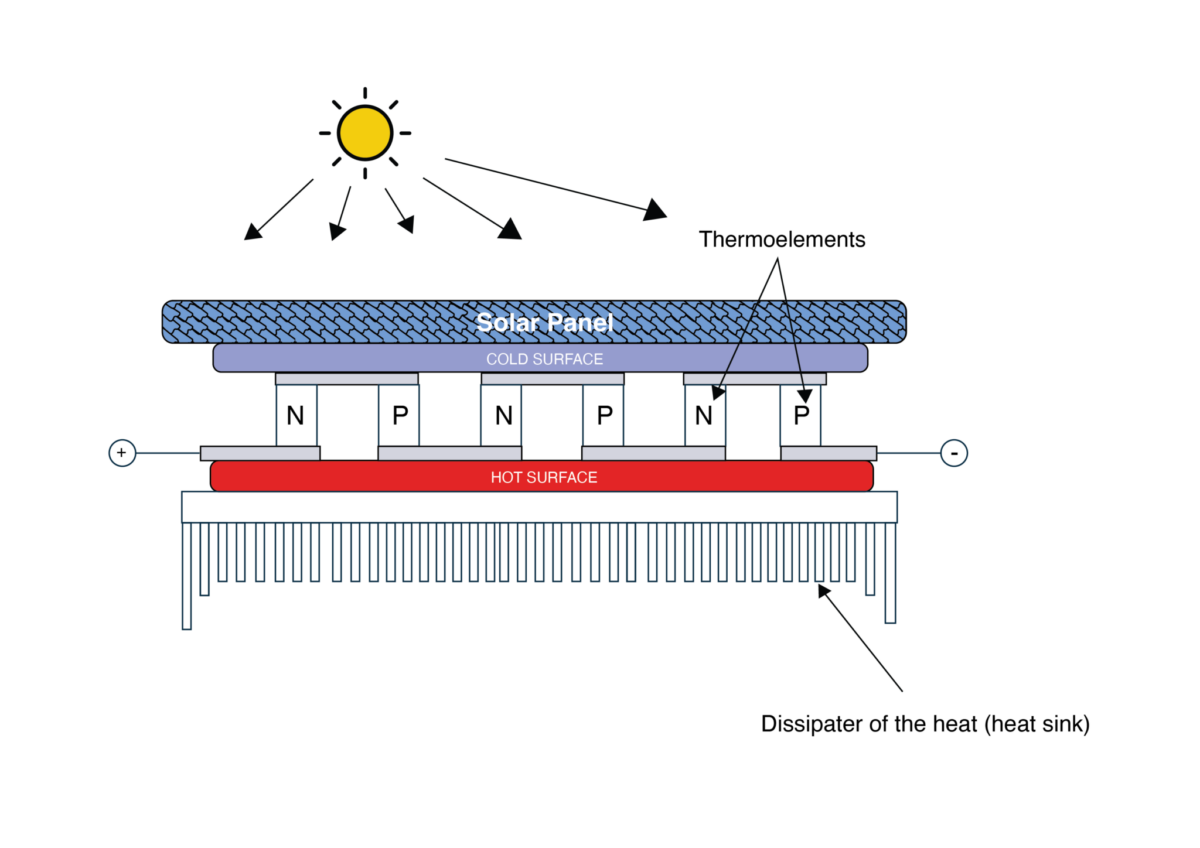A group of researchers from South Africa’s Central University of Technology has designed a solar module integrating a cooling system relying on a thermoelectric cooler (TEC).
TECs can convert heat into electricity through the “Seebeck effect”, which occurs when a temperature difference between two different semiconductors produces a voltage between the two substances. The devices are commonly used for industrial applications to convert excess heat into electricity. However, their high costs and limited performance have thus far limited their adoption on a broader scale.
“The PV-TEC system proposed in this study entails a PV panel integrated with a TEC device, affixed to its reverse side, a heatsink interconnected with the opposing face of the thermoelectric device, and a switching mechanism,” the scientists explained. “The TEC is powered by the PV panel it is intended to cool.”
The group conducted a numerical simulation to assess the performance of the system. In addition, an optimization function was set to maximize the output while trying to keep a targeted temperature of between 23 C and 27 C when the cell temperature exceeds 25 C. The PV panel used in the simulation had an output of 100 W, an efficiency of 17.8%, and a size of 20,200 cm3. The TEC had a maximum current of 6.1 A, a maximum voltage of 17.2 V, and a size of 6.08 cm3. The heat sink had a thermal resistance of 2.6 C/W and a size of 39.2 cm3.
“The scenario under consideration involves using meteorological data obtained from Bloemfontein, Free State, South Africa,” said the researchers. “The specific dataset encompasses diffuse horizontal, diffuse normal, and global horizontal irradiance, along with ambient temperature values, delineating a typical winter day on July 17, 2021, and a summer day on January 17, 2021.”
The operation of the system was analyzed for both a summer day and a winter day and its performance was compared to a reference PV panel without the TEC and the heat sink. Under the simulated winter conditions, the cell temperature never rose above 25 C, so the TEC was not active. Therefore, in both the PV-TEC case and the reference case, the peak temperature was recorded at 22.9 C, the constant power output was 86.9 W, and the total power production stood at 363.47 Wh.
In the summer case, however the TEC did kick into action, and allowed the panel to reach a peak output of 104.1 W, compared to 94.4 W in the reference case. The peak temperature in the reference was 36.1 C, while the PV-TEC did not breach 25 C. In the TEC case, it achieved an energy output of 603.60 Wh, compared to 547.65 Wh in the reference. “The results from our proposed model demonstrated a substantial improvement in output power, specifically by 9.27 % during the summer,” highlighted the academics.
Based on these results, the researchers moved to conduct an economic analysis with an assumed life of 20 years for the PV and the PV-TEC, as well as a 10% annual increase in electricity prices and a 6% interest rate. While the initial price of the 100 W solar panel alone was assumed at 1,235 ZAR ($66.9), the total cost for the PV-TEC case was 1,562.77 ZAR.
“The break-even point manifests relatively early within the project’s operational lifespan. To be precise, it transpires at the 6.5-year mark,” concluded the scientists. “The economic analysis further resulted in a cost saving of 2,905.61 ZAR, which is a 10.56 % project lifetime saving over 20 years.”
The system was presented in “Enhancing photovoltaic operation system efficiency and cost-effectiveness through optimal control of thermoelectric cooling,” published in Solar Energy Materials and Solar Cells.
This content is protected by copyright and may not be reused. If you want to cooperate with us and would like to reuse some of our content, please contact: editors@pv-magazine.com.








By submitting this form you agree to pv magazine using your data for the purposes of publishing your comment.
Your personal data will only be disclosed or otherwise transmitted to third parties for the purposes of spam filtering or if this is necessary for technical maintenance of the website. Any other transfer to third parties will not take place unless this is justified on the basis of applicable data protection regulations or if pv magazine is legally obliged to do so.
You may revoke this consent at any time with effect for the future, in which case your personal data will be deleted immediately. Otherwise, your data will be deleted if pv magazine has processed your request or the purpose of data storage is fulfilled.
Further information on data privacy can be found in our Data Protection Policy.